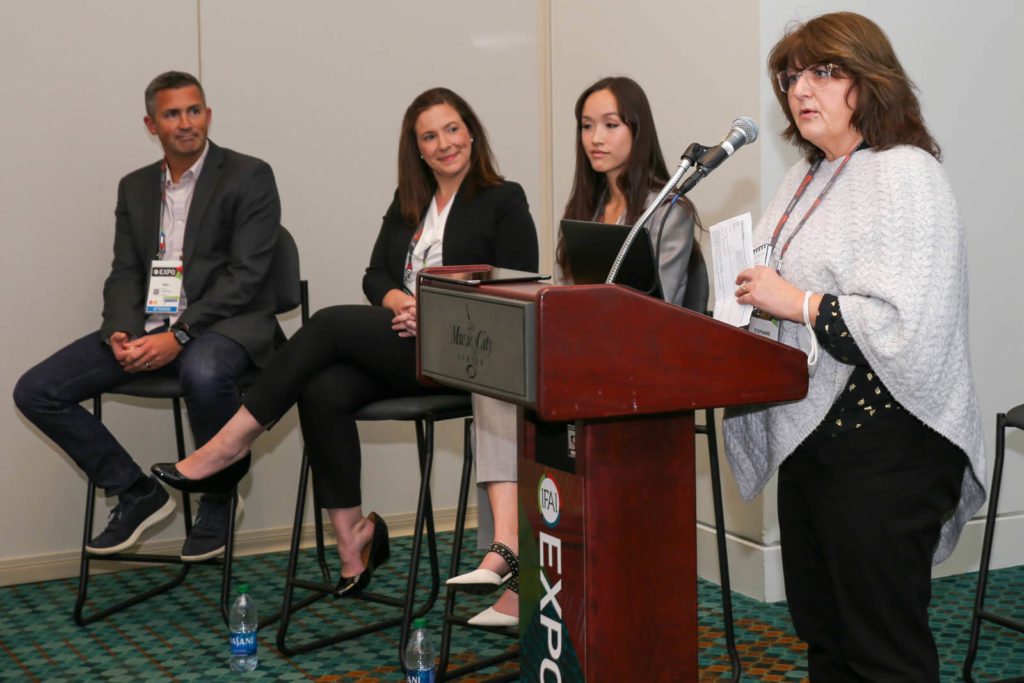
Advanced Textiles Conference speakers discuss the textile industry’s challenges.
by Marie O’Mahony and Janet Preus
As world leaders sat down for COP26 in Glasgow, sustainability panelists debated the impact of climate change at IFAI Expo in Nashville. The crisis is a global one, and one where the smart and advanced textiles industry is playing its role. As Sir David Attenborough pointed out at the opening ceremony for COP26, the motivation for tackling climate change “should not be fear, but hope.”
At this year’s Advanced Textiles (AT) conference, experts from across the industry came together to discuss and debate progress and key issues still to be addressed. Apex Mills’ Stephanie Rodgers moderated a panel of industry specialists: Meredith Boyd, Unifi; Lauren Choi, The New Norm Fabric; and Ben Mead, managing director, Hohenstein Institute America Inc.
Today’s design for tomorrow’s product.
Ben Mead at the Hohenstein Institute raised the issue of design for sustainability that needs to go beyond the label. “If we’re going to be serious about impacts, we have to get those products back in,” Mead says. No matter what they are—car seats or apparel or some sort of commercial textile—we are really designing those products to be able to have a future use.”
Shared responsibility.
Unifi’s Meredith Boyd sees Europe as being at the forefront of EPR (extended producer responsibility) with brands and retailers having additional responsibility assigned to figure out how a product fits in the recycling process. The sustainable fiber manufacturer and maker of REPREVE® polyester believes it has a responsibility to reduce the impact of using petrochemical derivatives. As they developed overseas, they also established regional capability also to avoid moving waste all around the world.
“There is a cost,” she acknowledges, “In order to avoid it being a competitive cost it does have to be shared.” The consumer is part of the chain and we have already seen an evolution from manufacturers inviting customers to post garments for recycling to them, to recycling bins being made available in stores and parking lots.

Technology’s role
“What about RFID tags or sensing technology?” Stephanie Rodgers asked the panel. She suggested that such technologies with their ability to harness, connect and disseminate data could be an invaluable sustainability tool. Rodgers suggested that RFID technology could be employed to help consumers who don’t know what to do. Radio-frequency identification (RFID) uses electromagnetic fields to automatically identify and track certain tags attached to objects, such as a fiber or textile.
Lauren Choi fully agreed that the consumer can and wants to be educated but sees such systems as incomplete. Apparel, in her opinion, is much more complicated to recycle than packaging, where tags are most commonly used for this purpose at present. While packaging can be PET, a garment might have several yarn types plus coatings or treatments. For that reason, she sees a need for other ways to sort textiles. She says RFID tags are useful as part of a broader approach, and the infrastructure for collection is crucial.
Chemical realities
One of the daunting challenges in addressing sustainability is understanding the chemical makeup of a textile product—most especially the list of banned (or potentially banned) chemicals. The use of chemicals in the manufacture of textiles continue to be of concern, in part because “It’s not reasonable to expect companies to know or reveal all the chemistries [in their products], says Mead, who also presented a session at the AT Conference.
So, what do companies do about understanding and then reporting exactly what’s in their products? Mead says there’s “a broad spectrum in what that looks like implementation,” which can be “simply hoping for the best and assuming somebody else has taken care of it,” or “nobody has told us there is anything to be done.”
There is more of a shift in the industry to disclosure requirements and on-site verification. However, the only way to know exactly what’s in your products is to test them. The reason to test is to learn “disclosed versus reality,” he says.
“Companies can’t disclose everything because they can’t always know everything. Some are only discovered via lab analysis,” he explains. “That will lead to the step of reformulation, when the actual ingredients are known, as well as the percentages.”
Hohenstein offers programs designed to assist manufacturers in meeting the institute’s sustainability labels’ specifications.
Establishing a more sustainable smart and advanced textiles industry will take time. Panel discussions and the level of audience engagement seen at IFAI Expo is testament to the fact that industry participants want to do the right thing. That there is no single way to be more sustainable makes measurement a challenge, but more positively it also creates opportunity to look at novel solutions. The one certainty is that sustainability will remain a topic of debate.
Dr. Marie O’Mahony is an industry consultant, author and academic. She is a regular contributor to Advanced Textiles Source.
Janet Preus is senior editor of Advanced Textiles Source. She can be reached at jlpreus@ifai.com
 TEXTILES.ORG
TEXTILES.ORG


